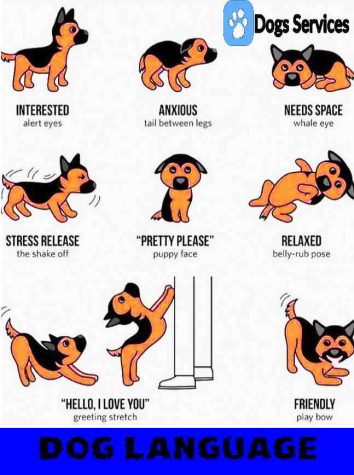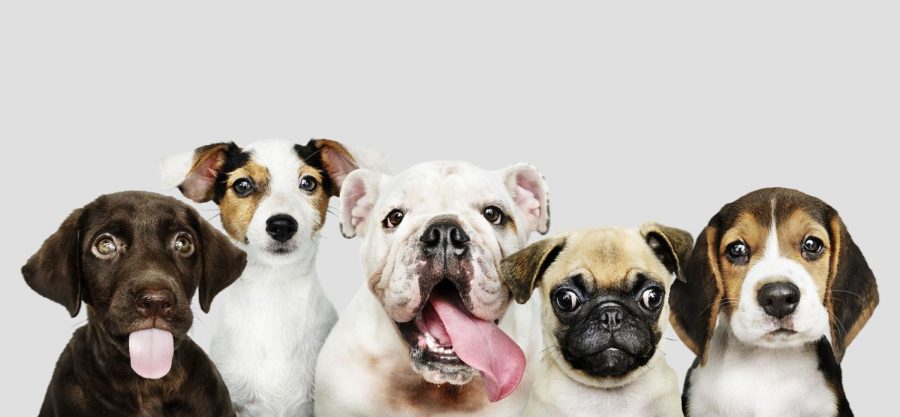Reading Signs From Your Four Legged Friend
January 24, 2022
Since pets are unable to talk, being able to use their body language is a major part in communicating with your pet. Dogs use several things including posture and facial expressions that owners need to try and understand. Dogs are able to communicate through different sounds like barking and whining and it’s important to understand the differences but they mainly rely on nonverbal communication.
Raised hackles
This is considered the human form of goosebumps. It is when dogs’ hair sticks up on their back. This is a sign that your dog is aroused but it’s not always a negative connotation. Some dogs get this way when they are very excited or it can also be very upset or stressed. The fur fluffing up is called piloerection.
Posture
Dogs have many different forms of postures that make them easier to read. An example of this would be when a dog hunches towards the ground. A dog does this when they are stressed or afraid. It is their way of trying to appear smaller and come across something that they might consider dangerous. It shows that they mean no harm. A more intense form is when a dog rolls on to their back. This can be a sign of relaxation but when another animal is around it is often referred to as an extreme form of anxiety.
Another posture dogs often use is when they shift their weight forward. This is a sign that a dog is interested in something and wants to be closer or more involved. While that can be a good thing, if another dog is around this is a sign of aggressive body language. The dog may feel threatened and is trying to look larger. This is a sign to remove your dog from the situation.
The play bow is another posture that we can read. This is described as when the dog puts its front end of their body to the ground with their butt in the air. As you may be able to tell from the name, the dog is ready to play. This posture has a positive connotation and is exciting to play with other dogs or even humans.
A signal that is harder to understand is when a dog raises her paw. This one can be confusing for humans but usually means the dog sees danger. This could include something they see as prey. If it’s not this situation, it is found to mean that they are insecure. They are uncertain about the situation they are in or going to be in so it results in the pointing behavior.
Tail Wagging
This is a form of communication that humans often misread. Many people see tail waggings as the dog is happy. While this can be true, it is not always the case. It could be a form of excitement but it can also be a form of frustration or even a more intense extreme. You have to look at the speed and the direction to be able to read the tail. The easiest way to read this is the faster the tail is moving the more aroused the dog is. When a dog is excited to meet a new person, it is more relaxed with the tail wagging. A faster twitch is a high level of arousal and typically is perceived in a negative way. This means the dog is standing on guard.
Recent studies have shown that the direction of the tail wagging is a major indicator of the dog’s emotion. Dogs’ tails typically move mostly towards the right when they are happy. This is a positive situation like interacting with owners. But when the dog tails starts moving more towards the left, the dog is showing a negative affection. Then, we have the helicopter wag which is a higher extreme of the right moment. This is definitely a sign your dog is happy and even more excited than the way to the right. This typically happens when a dog sees someone that they love.
We also can read the position of the dogs tail. To be able to do this, you need to know your dog’s natural posture. An example of this would be the Italian Greyhound who has a naturally curved tail so it can be a little harder to read. Typically a dog has a low tial that can even be tucked by legs when they are in a situation of fear. They have a raised tail when they are feeling confident but also a sign of aggression in some cases. Our dogs tail will be neutral or not raised or lowered tail when they are in a calm or relaxing situation. Being able to read this requires you to get to know your dogs natural position and judge is based on that.

Facial Readings
Dogs have similar facial features to humans but that does not mean they have the same meaning. A great example of this could be yawning. Humans typically yawn when they are tired but dogs use this more so in situations of stress. They can calm themselves or try to calm others, including their owners. This is used more oftenly in tense situations such as vet visits. But yawning may also take place if your dog sees you or somebody else yawn. Just like in humans, yawning is contagious.
Lip licking is another signal that is often misread. Dogs will lick their lips after a delicious meal like humans but typically it is a sign of anxiety. It can be hard to notice because the tongue flick can be quick but your dog is not signaling that they want to lick your face but instead discomfort.
Another confusing reading is dogs smiling. While dogs can smile when they are in a happy situation, it is usually read as a terrified expression. When a dog is happy, it is seen as a loose grin with a wiggly posture. Now when a dog is terrified, it is when they show their bare teeth. It is displayed as the corner of the lips form a shape and front teeth are displayed. This is a warning and is seen as they are showing a weapon they can use.
I talked with some students at Great Bend High School and they have seen their dogs use these different signals. First I talked with Catie Haberman. In all she has four pets including two dogs and two cats. I asked her if she is able to read when her pets are upset or happy. She told me she has noticed her dog Bailey gets nervous during thunderstorms and she gets excited when new people come around because “she wags her tail and sometimes even tinkles when she’s really excited”. She also said “I do believe I can read body language in both my dogs and cats because I’ve had pets ever since I’ve been a kid”. I also asked if she had any interesting stories to share about her pets and she said “One funny story is one time my cat Ciera went missing for about three months and we had almost lost hope that she was gone forever when we got a call from someone on the other side of town. Turns out she had hitched a ride on a trailer and made it across town”. I also talked with Brynn Miller who has six dogs. She told me she can tell when her dogs are nervous or happy because of there interactions. For example, wen they are happy they start barking. A funny story she has is “My dog named Rex fell asleep and fell off the back of the couch rolling in his sleep”.
These are some of the few signs you can try and read and understand and form a deeper connection with your dog. There’s many different websites out there to figure out more information on how to read other pets.



